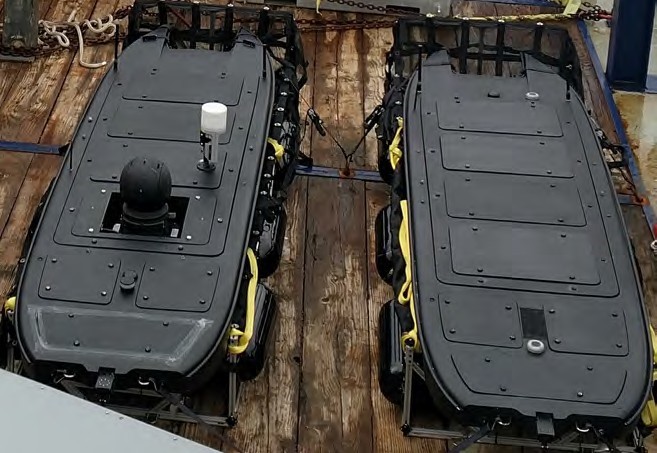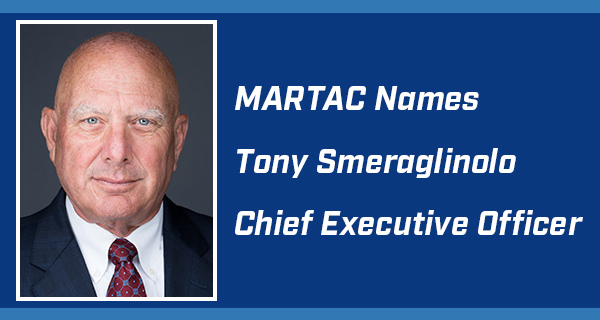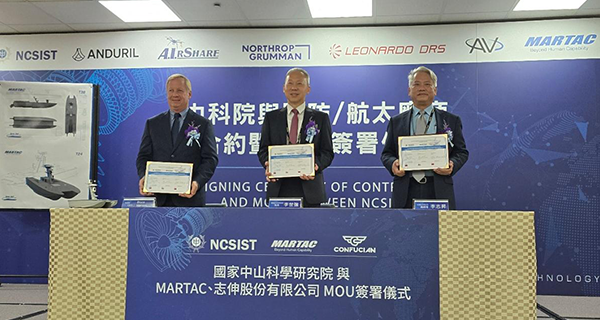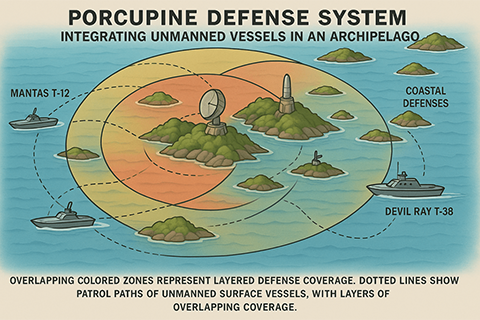Unmanned Logistics Can Supply the Beach and Beyond
- July 07, 2020
as Published in Future Force Vol. 6, No. 3, 2020
Getting Marines on the beach is only the first part of amphibious operational success. Making sure forces ashore get the supplies they need is what makes build up and exploitation possible. What if the moving those supplies ashore could be faster, easier and safer?
In their October 2019 article in Future Force, “Unmanned and Unafraid: The Transformation of Naval Oceanography,” Dr. William Burnett and Dr. K. Todd
Holland opened their piece with a provocative statement: “The question is not will the Navy use unmanned maritime systems in military operations, but rather how many will the Navy operate.” They note that “unmanned systems take the place of operations considered dull, dirty, or dangerous.”1
While their article focuses primarily on “dull” operations such as ocean observation, they suggest that the US military would be well served to consider them for “dirty” and “dangerous” roles in high-end warfare.2 As the US military pivots from wars in the Middle East and South Asia and addresses the need to be prepared for conflicts with peer competitors, it is time to consider unmanned vehicles in a new light and consider new ways that these emerging technologies can support US military operators.
While there are many types of unmanned systems—air, ground, surface, and subsurface—this article will focus on unmanned maritime systems (surface and subsurface), as they have not received as much attention. Today, the unmanned systems are finally emerging as systems that can keep warfighters out of harm’s way by taking on much of the dull, dirty, and dangerous work that previously put Sailors and Marines at risk.
The Technology-Based Unmanned Renaissance
“My view is that technology sets the parameters of the possible,” writes military historian Max Boot in his book War Made New, “it creates the potential for a military revolution.”3 He supports his argument with historical examples to show how technology-driven “revolutions in military affairs” have transformed warfare at different
times. He points out the importance of technology in giving militarily innovative nations war-winning advantages.
In his book Wired for War: The Robotics Revolution and Conflict in the 21st Century, P.W. Singer makes the argument that robots (unmanned systems) will change the character of warfare. He offers examples of how these systems are
already transforming the way that the United States wages war, describing the military application of everything from the practice of having unmanned PackBots deal with deadly improvised explosive devices, to the employment of large unmanned aerial vehicles such as Global Hawk to provide comprehensive surveillance of wide swaths of territory, to the use of a wide variety of drones such as Predator and Reaper to kill terrorists from a distance.4 His assertions regarding the potential and promise of the use of unmanned systems in future wars have not been lost on US defense and military officials who have expressed an increasing interest in unmanned systems.
The 2018 National Defense Strategy has an intense focus on technology and notes that the United States will not achieve the security and prosperity it seeks
without harnessing advancing technologies to support its warfighters, noting:
The security environment is also affected by rapid technological advancements and the changing character of war. The drive to develop new technologies is relentless, expanding to more actors with lower barriers of entry, and moving
at accelerating speed. New technologies include advanced computing, big data analytics, artificial intelligence, autonomy, robotics, directed energy, hypersonics, and biotechnology—the very technologies that ensure we will be able to fight and win the wars of the future.5
One of the most rapidly growing areas of innovative technology adoption by the military involves unmanned systems. In the past several decades, the US military’s use of unmanned aerial vehicles (UAVs) has increased from only a handful to more than 10,000, while the use of unmanned ground vehicles (UGVs) has exploded from zero to more than 12,000. The use of unmanned surface vehicles (USVs) and unmanned underwater vehicles (UUVs) also is growing, as both of these are proving
to be increasingly useful for a wide range of military applications.6 These systems have been used in the conflicts in Iraq and Afghanistan, and will continue to be equally relevant—if not more so—as strategic focus shifts toward the Asia-Pacific region.7
Most military officials agree that unmanned systems have a crucial role in providing the United States with dominance on the battlefield. The Department of Defense’s vision
for unmanned systems is to integrate these systems into the joint force for a number of reasons, but especially
to reduce the risk to human life in high-threat areas, to deliver persistent surveillance over areas of interest, and to provide options to warfighters that derive from the inherent
advantages of unmanned technologies—especially their ability to operate autonomously.
The importance of unmanned systems to the US Navy’s future has been highlighted in a series of documents, ranging from the revised A Cooperative Strategy for 21st Century Seapower, to A Design for Maintaining Maritime Superiority, to a chief of naval operations The Future Navy white paper. The latter document presents a compelling case for the rapid integration of unmanned systems into the fleet, noting:
There is no question that unmanned systems must also be an integral part of the future fleet. The advantages such systems offer are even greater when they incorporate autonomy and machine learning…………. Shifting more heavily to unmanned
surface, undersea, and aircraft will help us to further drive down unit costs.8
The Navy is making an enormous commitment to unmanned systems—especially unmanned surface systems. For example, the Navy is establishing a Surface Development Squadron, to experiment with unmanned ships.9 Future development ideas call for a “ghost fleet” of autonomous unmanned surface ships that could operate against an enemy force without putting Sailors in harm’s
way.10 Fortunately for the US military, under the stewardship of organizations such as the Defense Advanced Research Projects Agency, ONR, and the nation’s military laboratories, decades of work have resulted in the development of unmanned systems that have been delivered to warfighters. While the exigencies of the wars in Afghanistan and Iraq necessitated the accelerated development and fielding
of aerial and ground systems, the potential for conflict against high-end adversaries has meant the development of unmanned maritime vehicles has grown in importance.
Evaluating Unmanned Surface Vehicles

The Navy and Marine Corps have a lot to learn about unmanned surface vehicles, and there is a palpable desire to put them in the hands of Sailors and Marines. Navy- Marine Corps exercises, experiments, and demonstrations— such as a series of advanced naval technology exercise events and the annual Bold Alligator series—have looked
at a wide range of emerging technologies, including unmanned vehicles that can make expeditionary assault forces more lethal, agile, and survivable. Other events have examined different missions conducted by the Navy-Marine Corps team, specifically the logistics and sustainment function.
Logistics have been central to warfare for many millennia. For the Navy-Marine Corps team, this plays out most
prominently during an amphibious assault. The Valiant Shield exercise, overseen by Marine Forces Pacific and conducted on the Marianas Island Range Complex, experimented with using this emerging technology to provide sustainment to Marines on the beachhead during this critical juncture of an amphibious assault.
Marines in the fight use enormous quantities of fuel, food, ammunition, and other materiel as they attempt to move off the beachhead. While many functions are important in an amphibious operation, once the assault is under way and Marines are on the beach, sustainment is crucial in ensuring their success. Two researchers at the Royal United Services
Institute put it this way, “The capacity of Marines to push inland must depend on the security of their logistical support.”11
Using manned naval craft for this sustainment mission puts operators at unnecessary risk of enemy fire, and in proximity to near-shore obstacles that were not cleared prior to the assault phase. Using scarce manned craft to perform this mission also takes them away from more important roles. That is why this major Navy-Marine Corps amphibious exercise evaluated the ability of unmanned surface vehicles to conduct this sustainment mission.
Marine Forces Pacific used USVs during Valiant Shield to resupply the landing force. The exercise coordinator used a catamaran-hulled, 12-foot MANTAS USV to provide rapid
ship-to-shore logistics sustainment. This small, autonomously operated USV carried just 120 pounds of cargo, but the proof of concept worked and demonstrated that unmanned surface
vehicles could effectively resupply troops ashore.
Using unmanned vehicles for the sustainment mission can be a game changer for expeditionary assault forces. Beyond taking operators out of harm’s way, using USVs in this role frees manned craft for other missions. In addition, having
a continuous, preprogrammed logistics resupply process to perform one of the dull, dirty, and dangerous functions important in an amphibious assault means there is one less thing for commanders to have to manage during these operations.
This proof of concept with a 12-foot MANTAS USV achieved positive results. Resupply in 120-pound increments, however, is far less than is required to provide what is needed by Marines on the beach. The Valiant Shield exercise provided the impetus and inspiration to continue to explore the
use of USVs for amphibious force sustainment. The Navy and Marine Corps are looking to scale up small USVs and continue to experiment with using larger USVs to provide greater sustainment quantities.
Scaling Up to Deliver Logistics Capabilities
To undertake this effort, the maker of the MANTAS family of vehicles (Maritime Tactical Systems) was asked by the Navy and Marine Corps to develop larger proof-of-concept USVs for this logistics sustainment mission using the same catamaran hull design as the smaller vessel used in Valiant Shield.
Larger MANTAS unmanned surface vehicles from 38 to 50 feet long are being constructed for further review by Navy and Marine Corps officials during upcoming
exercises, experiments, and demonstrations such as Trident Warrior 2020. This may
not be the ultimate size for the USV the expeditionary assault force needs as a long- term solution, but it will go a long way to advancing the state of the art in unmanned semiautonomous or autonomous logistics support.
There are larger USVs that can be evaluated by the Navy and Marine Corps, but the basic specifications of the 38- foot (T38) and 50-foot (T50) MANTAS will provide an indication of the ability of USVs
to provide a continuous stream of logistics support to Marines on the beach. The T38
can carry a payload up to 4,500 pounds, while the T50 can carry a payload of up to 10,000 pounds. The vessels travel at cruise speeds greater than 25 knots. Given the speed and carrying capacity these USVs, it is readily apparent how it can fulfill this, as well as other, important logistics functions.
Delivering Logistics Sustainment to Troops Ashore

As any observer can see from a hilltop near one of several Marine Corps bases, an amphibious formation typically stands no more than 15-25 nautical miles off the beach being assaulted. Using a notional stand-off distance of 20 nautical miles, an amphibious formation equipped with four T38s traveling at their conservative cruise speed of 25 knots could deliver 18,000 pounds of material from the amphibious ships to the beach per hour, allowing the short time needed for loading and unloading the craft. Multiply that by 24 hours and you get a buildup of greater than 400,000 pounds of vital material per day, enough to support a substantial force of troops ashore. For four T50s, the number is even higher, more than 800,000 pounds per day.
Both T38 and T50 are modular and can keep cargo dry in the turbulent surf zone. In addition, given the fact that an
adversary will endeavor to fire on unmanned craft attempting to resupply the landing force, each vessel can operate
in “gator mode,” where the main deck is awash and only equipment such as cameras and radar are exposed above the water surface, making each USV much harder to target.
In addition to the upcoming Trident Warrior and RIMPAC exercises in the summer of 2020, the Navy is planning an ambitious range of exercises in the years ahead: several advanced naval technology exercises, Sea Dragon, Bold Alligator, Valiant Shield, Valiant Blitz, Large Scale Exercise 2020, and others. Based on the promising performance of small unmanned surface vessels in support of expeditionary assault forces, the Navy and Marine Corps would be well served to experiment further with larger USVs to perform this vital logistics sustainment mission.
Lt. Cmdr. Rowley
is the chief technology officer for Maritime Tactical Systems.





